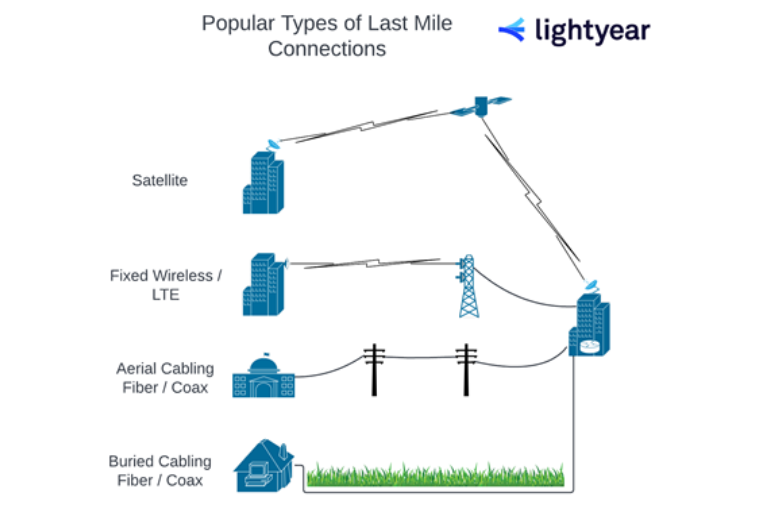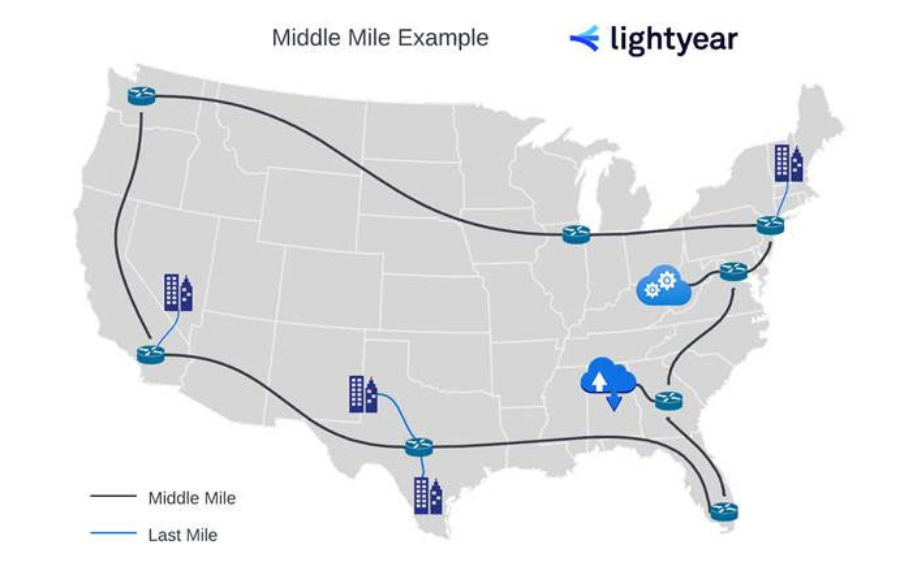Last Mile vs. Middle Mile vs. Long Haul Connectivity
In this post, we'll help you understand last mile connectivity, middle mile connectivity, and long-haul connectivity and how they play a role in your network.

Feb 1, 2023
SHARE
Telecom-speak like “last mile connectivity” and “middle mile connectivity” doesn’t make for engaging dinner-party conversation, but it will help you navigate confidently through complicated telecom procurement processes.
So you are soon in a position to hold a boring dinner party conversation, let’s go ahead and better understand what long haul, middle mile, and last mile connectivity actually are.
Last Mile Connectivity
Internet connectivity is a round trip – data goes out, data comes in. So, it gets tricky when you try to describe different parts of a data packet’s journey
When we talk about the last mile, it’s important to understand this description as being from the internet service provider’s perspective. Seen from this position, the last mile is the final part of the telecommunications network chain – the part that physically reaches the customer’s property. When you buy a consumer broadband service from Comcast or Spectrum, you’re buying last mile connectivity access.
From the customer’s perspective, this same portion of the network could just as easily be described as the first mile. The fact that the language used reflects the ISP’s point of view perhaps highlights a bit of long-standing industry neglect. This lack of customer-centric thinking betrays the legacy roots of an industry that until fairly recently was dominated by monopolistic behemoths – most of whom are still very much in the driving seat.
But let’s climb down off the soapbox and explain a little more about the last mile.

What You Need to Know About Last Mile Connectivity
Different types of network link require different types of last-mile connectivity. Depending on the kind of network service you require, your last-mile needs could vary considerably. MPLS (multi-protocol label switching) is a good example – if you need to connect a location outside of your MPLS provider’s network infrastructure, then your provider will need to procure dedicated last-mile connectivity from another company in that area to provide you with service.
Not all last mile transport mediums are created equal. For most locations, there are several options for your last mile, across various types of physical transport medium (fiber, copper, wireless, etc.) – but they’ve all got their own advantages and limitations. Satellite internet can provide a great last-mile solution, especially in remote areas, but there are some drawbacks – the levels of delay (or latency) involved in sending your data into space and back again can make some online activities (such as video calls) a nightmare. If you’re in a distant location and need low latency, you might want to investigate a fixed wireless solution first.
Building “Plan B” into your last mile. For businesses and organizations that can’t afford their internet to go down – even in extreme circumstances – planning a diverse, redundant internet circuit must start from the last mile. Procuring two separate circuits from two providers with separate last-mile infrastructure will ensure diverse redundancy, as will using separate access routes into the building, for example using aerial and buried cabling.
Last-mile connectivity – the key takeaway… is that the performance of your last mile – and consequently, your internet connection as a whole – is dependent on how the signal leaves and arrives at your location, and which ISP you’ve chosen to provide it over what transport medium.
Middle Mile Connectivity
So, we’ve looked at the last mile, and we’re about to look at the long haul – no prizes for guessing where you can find the middle mile. Middle mile connectivity lies between the last mile and the greater internet backbone.

What You Need to Know About Middle Mile Connectivity
For many ISPs, the middle mile is their “core” network. Unless you’re a Tier 1 ISP, a middle-mile network is about as much “turf” as you can expect to claim.
ISPs can get a lot of use out of their middle mile. As well as being a way to securely link their data centers, a middle-mile network allows your ISP to offer MPLS services between locations, or to augment SD-WAN and SASE services with a secure middle mile.
ISPs with their own middle mile offer greater consistency. With all that extra control, your ISP can confidently offer more predictable site-to-site connectivity and performance.
ISPs with their own middle mile give better performance for cloud-based services. Often, a middle-mile ISP will secure adjacent data-center space with a cloud-based service provider, allowing them to provide lower latency, better security, and consistent performance for a customer’s cloud-based apps. If you need consistent cloud-based connectivity for your business, it’s essential to ask prospective ISPs about their middle mile before anything gets signed.
Middle-mile connectivity – the key takeaway… is that anyone who needs ultra-reliable, cloud-based services and/or site-to-site direct networking at a reasonable price, needs to be looking at ISPs with a robust middle-mile network.
Long Haul Connectivity
Long-haul circuits form the backbone of the internet. Owned almost entirely by Tier 1 ISPs – the “big beasts,” most of whom have evolved from the old monopolies like British Telecom or Verizon. Most long-haul circuitry takes the form of heavy duty cabling which spans huge distances between states and countries (much of its submarine cabling on the ocean bed, providing subsea connectivity).
What You Need to Know About Long Haul Connectivity
Carriers use long haul cables to connect their major network nodes together and form their middle mile (or core/backbone) network.
If an enterprise customer is working towards setting up their own site to site network over dedicated links, the term Long Haul will be used often when referring to the wavelength (DWDM) network connections that are typically used. This is a very effective and secure way to establish a private network, but these connections typically come at a significant cost.
Long-haul connectivity – the key takeaway… is that you’re only likely to need to discuss this in depth if you’re building a dedicated end-to-end network.
It’s always good to turn confusing jargon like “last-mile connectivity” and “long haul” into solid knowledge. Here at Lightyear, we take pride in helping people cut through the clutter. Our automated telecom procurement platform makes it even easier to navigate this complex and sometimes murky world of business telecoms (and if you still need extra guidance, our industry experts are ready to jump in at any point).
Want to learn more about how Lightyear can help you?
Let us show you the product and discuss specifics on how it might be helpful.
Not ready to buy?
Stay up to date on our product, straight to your inbox every month.
